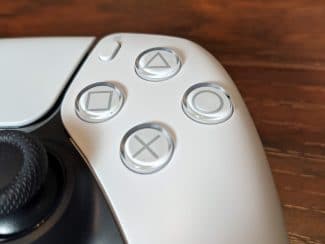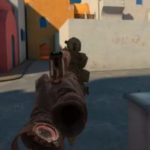(Update 02/23/21): Today, Sony announced an upcoming next-generation PSVR headset built specifically for PS5 that will include new controllers based on DualSense technology. As a result, we’ve republished this editorial from when the PS5 first launched late last year.
(Original 10/27/20): One of Sony’s most impressive innovations for the PlayStation 5 will likely be one of its least talked about features at first: the way the DualSense PS5 Controller feels in your hands. But I think this could be our first real look at what the future of haptics in VR could hold.

DualSense PS5 Controller
I’ve tried out all sorts of interaction methods for VR. I’ve used the wide range of consumer-facing VR controllers like Oculus Touch, PS Move, the PS Aim Controller, the Vive wands, the Windows Mixed Reality controllers, the new Vive Cosmos controllers, and of course the litany of one-handed mobile VR controllers. All of those pale in comparison to the Valve Index “knuckles” controllers though, in my experience, because the Index controllers are the best at making you forget there’s a controller in your hand.
VR is all about giving into an illusion, but it’s hard to fully commit mentally when a hunk of plastic is required to interface with the digital world. Hand-tracking is a neat solution, but we’re a ways off from that being very accurate and without gloves it’s missing a crucial component: haptics.
Sony’s DualSense PS5 Controller doesn’t’ do much in the way of eliminating the feeling of holding a controller, obviously, but it makes some serious leaps and bounds forward for haptics.
Watch + Read More: PlayStation 5 and DualSense Controller Unboxing
For as long as I can remember, perhaps since the Nintendo 64’s Rumble Pak, controller vibration has felt mostly the same. The Nintendo Switch has “HD Rumble” in the Joycons which try to be a little more precise, but those controllers are so tiny they’re inherently limited. The DualSense takes it to a whole other level.
It’s a two-fold solution for Sony with the PS5’s DualSense Controller: adaptive triggers and reactive rumble. The adaptive triggers change and adjust the amount of tension provided and pressure needed to interact with the game. The small slice of Astro’s Playroom I’m allowed to talk about right now does this wonderfully with a spring-loaded robot character that requires you to firmly press down the R2 button just past the point of full tension, then release it to launch him.
Just like VR and AR itself, it’s very difficult to describe the sensation in words, but it feels like a spring magically appeared inside the controller to resist me pushing down and then later, once I’m out of the robot, it vanishes.
This is important to note because not only was it incredibly impressive from a technical perspective, but also because of the variation. At other points in the game the tension is used differently for different actions and to varying degrees of intensity. There’s nuance to it, it’s not just a yes/no scenario for whether or not there’s tension.
In the video above at the embedded time (2:58) I talk a bit about this concept with some gameplay footage to help explain.
The other facet of the DualSense PS5 Controller I was most impressed with is in the way of its reactive rumble. What I mean by this is that depending on what you’re doing in the game or where you’re going, the controller feels different in your hands. It reminded me a bit of Ultra Haptics, a company that used air to precisely press against your hands and simulate touch. Instead of air, the DualSense Controller just lightly and very precisely vibrates in your palms.
For simple actions like punching an enemy or landing on the ground it’s a quick jolt that feels similar to what you’d see in any other game controller on the market, but when you have Astro walk across different surfaces that’s when it really shines. I could literally feel the difference between sand, metal, wood, and even glass just from the way the controller felt in my hands. It’s impossible to describe adequately, but let me just say that if I closed my eyes I could probably still identify the surface based on how it feels. The sound coming from the controller is extremely crisp as well with a great little speaker that’s far better than the speaker which no developers ever seemed to use on the DualShock 4 for PS4.

Implications for PSVR
Now you might be wondering what all of this has to do with VR. For starters, many made-for-PS5 VR games are likely to use the standard DualSense PS5 Controller. The reason for this is that it’s the lowest common denominator — everyone with a PS5 has one — and it’s a known device. So, analyzing what this controller can do is important. There is a gyroscope in there, you have to use it to aim and point around inside Astro’s Playroom in a 3DOF capacity. The PS Camera requires an adapter I don’t have yet and the new HD PS5 Camera is presumably not used for tracking at all, but I also can’t be sure because DualSense does have a light around the trackpad but I wasn’t sent a camera for review.
But the larger reason for this analysis is the fact that this exact same technology — adaptive triggers and precise, reactive rumble — is likely going to be used in the controllers for the next iteration of the PlayStation VR headset. The original PSVR uses an archaic PS3-era tracking technology based on colored lights and bulbs on the ends of wand-shaped controllers. It’s silly and often imprecise, but it got the job done for the most part given its age. Reportedly, Sony is working on something much more impressive for the next headset.
We have no idea what that actually is, but for what it’s worth, the technology in the DualSense could absolutely make new VR experiences even more immersive. If developers could tap into the power of the DualSense and let us feel things more accurately or squeeze and hold things more realistically, that could do wonders for immersion. I’m excited to see what developers are working on.

What do you think? Do you think DualSense could point towards an exciting future for PSVR on PS5? Let us know down in the comments below!





